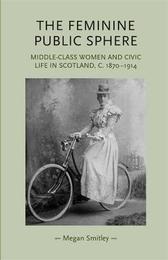
|
The Feminine Public Sphere: Middle-Class Women and Civic Life in Scotland, c. 1870-1914
Hardback
Main Details
| Title |
The Feminine Public Sphere: Middle-Class Women and Civic Life in Scotland, c. 1870-1914
|
| Authors and Contributors |
By (author) Megan Smitley
|
| Series | Gender in History |
|---|
| Physical Properties |
| Format:Hardback | | Pages:192 | | Dimensions(mm): Height 216,Width 138 |
|
| Category/Genre | British and Irish History |
|---|
| ISBN/Barcode |
9780719079665
|
| Classifications | Dewey:305.48962209411 |
|---|
| Audience | | Undergraduate | | Postgraduate, Research & Scholarly | |
|---|
| Illustrations |
Illustrations, black & white|Tables
|
|
Publishing Details |
| Publisher |
Manchester University Press
|
| Imprint |
Manchester University Press
|
| Publication Date |
1 November 2009 |
| Publication Country |
United Kingdom
|
Description
At a time when women were barred from clerical roles, middle-class women made use of the informal power structures of Victorian and Edwardian associationalism in order to actively participate as citizens. This investigation of women's part in civic life provides a fresh approach to the 'public sphere', illuminates women as agents of a middle-class identity and develops the notion of a 'feminine public sphere', or the web of associations, institutions and discourses used by disenfranchised middle-class women to express their citizenship. The extent of middle-class women's contribution to civic life is examined through their involvement in reforming and philanthropic associations as well as local government. Making use of a range of previously untapped sources, this fascinating book will appeal in particular to those with an interest in Gender History and Scottish History. -- .
Author Biography
Megan Smitley is a former ESRC Post Doctoral Fellow, having attained her PhD in History and Economic and Social History from the University of Glasgow -- .
ReviewsSmitley's concept of a feminine public sphere is an original contribution to the growing body of work that challenges the ideology of separate spheres sharply divided by gender. Although the involvement of women in public action together with their self-representation has been highlighted before, Smitley makes space for women within the public culture of the civic elite, which urban historians, drawing on the early ideas of Jurgen Habermas, have depicted as male territory. Eileen Janes Yeo, Victorian Studies volume 54, No. 2 -- .
|